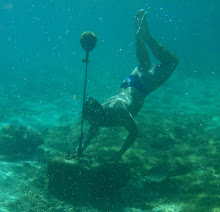
After having done the Jindalba Boardwalk and a bit of driving we decided to head towards Cow Bay. It was not really weather for getting in the water, but judged by the amount of danger signs we were met by at the beach, that is not even something you would consider up north this time of year :-)

There were all the usual warning signs alerting you about the various dangers lurking in the water .. and a few new ones! Up north you have to be particular careful of marine stingers, like the notorious
box jellyfish Chironex Fleckeri. As the sign reads, they are present during the summer months, however, if you ask one of the locals about the safety in going swimming, they will argue that the stingers do not know the calender so why take a chance.

Even if we had considered taking a chance with the stingers, we would not have been able to hit the water this rainy afternoon - a good size
saltwater crocodile had been seen at the northern end of the beach where a freshwater creek was running into the ocean. Good stuff! A good firm grip on the camera and we headed north to get some pictures of the monster :-)

We never saw the monster of Cow Bay! Maybe we were to busy keeping a good distance to any potential hiding place for a good size reptile? We saw a frog belonging to a very different weight class and a few good birds. Varied Triller male and female below and our first Spectacled Monarch.


A good stroll along the beach and some of the exotic fruits we had stocked up on in Cairns and we were ready for the final part of our Daintree adventure.

As some of you readers might remember, we had invested in a never ending cruise ticket allowing us to take another go on the Daintree River, yours truly have a hard time saying no to free stuff, so we once again found ourselves on the River in a
tinny. This time about 13km downstream from Daintree Village.

Crocodiles are very clever animals! They understand that there is no reason to fight the force of a fast flowing river. So instead of using huge amounts of energy swimming against the current, they will just let the river take them downstream and wait for calmer waters before making their way back to a favorite sand bank. This also meant that we had much better views of these ancient creatures during this our third cruise of the Daintree River.

A couple of salties and a green tree snake or two seems to be what people can expect on these tours. Not bad at all, I managed to get a few slightly better pictures during this trip, including the juvenile crock in the very top of this blog post.

All good - the Daintree is a absolutely fantastic spot! It would have been lovely having more time to explore, but in our attempt of covering as much of Far North Queensland as possible we were heading for the Atherton tableland where we were expecting equally great adventures.

As the sun sank in the East we had quite a few good bird sightings. In less than 5 minuets of driving from the ferry, a Blue-winged Kookaburra and a flock of Channel-billed Cuckoos made us stop for a few pictures. Whereas the usual suspects, such as Forest Kingfisher and Yellow-bellied Sunbird already at this stage seemed so very common :-D



















































